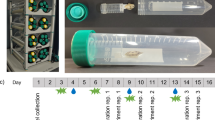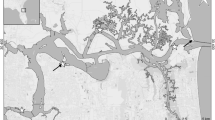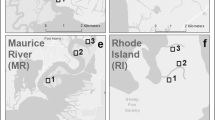Abstract
The ribbed mussel (Geukensia demissa, Dillwyn 1817) is a dominant benthic filter-feeder in salt marshes along the North American Atlantic Coast. It has been proposed that the cultivation and harvest of ribbed mussels could be used to bioremediate the eutrophication of coastal waters. To accomplish this, mussels would be grown in suspension culture underwater, which is different than this species’ natural, intertidal habitat in which they are exposed to a tidal regime of submersion and emersion. To assess possible effects of constant submersion upon the feeding behavior of G. demissa, we quantified filter-feeding activities of ribbed mussels collected from either an intertidal location or a permanently submerged (2 months) population in the same embayment. Filtration measurements to determine clearance rates were conducted in aquaria containing ultra-filtered seawater with cultured phytoplankton. Results show that mussels taken from the intertidal population had significantly higher filtration than the submerged population initially, but after 3 days of submersion in the aquaria, this difference disappeared. Moreover, all experimental G. demissa had higher clearance rates during natural low tide than during natural high tide. These results indicate a potential for ribbed mussels to be grown in suspension culture for nutrient bioextraction purposes.

Similar content being viewed by others
References
Abbott RT (1974) American seashells. Litton Educational Publishing, New York
Bayne BL, Hawkins AJS, Navarro E (1988) Feeding and digestion insuspension-feeding bivalve molluscs: the relevance of physiological compensation. Am Zool 28:147–159
Beentjes MP, Williams BG (1985) Endogenous circatidal rhythmicity in the New Zealand cockle Chione stutchburyi (Bivalvia, Veneridae). Mar Behav Physiol 12:171–180
Bertness MD, Grosholz E (1985) Population dynamics of the ribbed mussel, Geukensia demissa: the costs and benefits of an aggregated distribution. Oecologia 67:192–204
Doeller JE, Gaschen BK, Parrino V et al (1999) Chemolithoheterotrophy in a metazoan tissue: sulfide supports cellular work in ciliated mussel gills. J Exp Biol 202:1953–1961
Doeller JE, Grieshaber MK, Kraus DW (2001) Chemolithoheterotrophy in a metazoan tissue: thiosulfate production matches ATP demand in ciliated mussel gills. J Exp Biol 204:3755–3764
Espinosa EP, Allam B, Ford SE (2008) Particle selection in the ribbed mussel Geukensia demissa and the Eastern oyster Crassostrea virginica: effect of microalgae growth stage. Estuar Coast Shelf Sci 79:1–6
Howarth RW (1984) The ecological significance of sulfur in the energy dynamics of salt marsh and coastal marine sediments. Biogeochemistry 1:5–27
Jordan TE, Valiela I (1982) A nitrogen budget of the ribbed mussel, Geukensia demissa, and its significance in nitrogen flow in a New England salt marsh. Limnol Oceanogr 27:75–90
Kautsky N (1982a) Growth and size structure in a Baltic Mytilus edulis population. Mar Biol 68:117–133
Kautsky N (1982b) Quantitative studies in gonad cycle, fecundity, reproductive output and recruitment in a Baltic Mytilus edulis population. Mar Biol 68:143–160
Kemp PF, Newell SY, Krambeck C (1990) Effects of filter-feeding by the ribbed mussels Geukensia demissa on the water-column microbiota of a Spartina-alterniflora saltmarsh. Mar Ecol Prog Ser 59:119–131
Kim W-S, Huh H-T, Je J-G et al (2003) Evidence of two-clock control of endogenous rhythm in the Washington clam, Saxidomus purpuratus. Mar Biol 142:305–309
Kittner C, Riisgård HU (2005) Effect of temperature on filtration rate in the mussel Mytilus edulis: no evidence for temperature compensation. Mar Ecol Prog Ser 305:147–152
Kooijman SALM (2010) Dynamic energy budget theory for metabolic organisation. Great Britain
Kreeger DA, Newell RIE (2001) Seasonal utilization of different seston carbon sources by the ribbed mussel, Geukensia demissa (Dillwyn) in a mid-Atlantic salt marsh. J Exp Mar Biol Ecol 260:71–91
Kreeger DA, Newell RIE, Langdon CJ (1990) Effect of tidal exposure on utilization of dietary lignocellulose by the ribbed mussel Geukensia demissa (Dillwyn) (Mollusca: Bivalvia). J Exp Mar Biol Ecol 144:85–100
Langdon CJ, Newell RIE (1990) Utilization of detritus and bacteria as food sources by 2 bivalve suspension-feeders, the oyster Crassostrea virginica and the mussel Geukensia demissa. Mar Ecol Prog Ser 58:299–310
Langton RW (1977) Digestive rhythms in the mussel Mytilus edulis. Mar Biol 41:53–58
Langton RW, Gabbott PA (1974) The tidal rhythm of extracellular digestion and the response to feeding in Ostrea edulis. Mar Biol 24:181–187
Lee RW, Kraus DW, Doeller JE (1996) Sulfide-stimulation of oxygen consumption rate and cytochrome reduction in gills of the estuarine mussel Geukensia demissa. Biol Bull 191:421–430
Leibold MA (1995) The niche concept revisited: mechanistic models and community context. Ecology 76:1371–1382
Lent CM (1969) Adaptations of the ribbed mussel, Modiolus demissus (Dillwyn), to the intertidal habitat. Am Zool 9:283–294
Lonsdale DJ, Cerrato RM, Holland R et al (2009) Influence of suspension-feeding bivalves on the pelagic food webs of shallow, coastal embayments. Aquat Biol 6:263–279
Mathers NF (1976) The effects of tidal currents on the rhythm of feeding and digestion in Pecten maximus L. J Exp Mar Biol Ecol 24:271–283
Mohlenberg F, Riisgård HU (1978) Efficiency of particle retention in 13 species of suspension feeding bivalves. Ophelia 17:239–246
Morton BS (1970) The tidal rhythm of feeding and digestion in Cardium edule. J Mar Biol Ass UK 50:499–512
Morton BS (1977) The tidal rhythm of feeding and digestion in the pacific oyster, Crassostrea gigas (Thunberg). J Exp Mar Biol Ecol 26:135–151
Richardson CA (1988) Exogenous and endogenous rhythms of band formation in the shell of the clam Tapes philippinarum (Adams et Reeve, 1850). J Exp Mar Biol Ecol 122:105–126
Riisgård HU (1988) Efficiency of particle retention and filtration rate in 6 species of Northeast American bivalves. Mar Ecol Prog Ser 45:217–223
Riisgård HU (2001) On measurement of filtration rates in bivalves: the stony road to reliable data: review and interpretation. Mar Ecol Prog Ser 211:275–291
Rodland DL, Schöne BR, Helama S et al (2006) A clockwork mollusc: ultradian rhythms in bivalve activity revealed by digital photography. J Exp Mar Biol Ecol 334:316–323
Rose JM, Tedesco M, Wikfors GH et al. (2010) International workshop on bioextractive technologies for nutrient remediation summary report. pp 12 in US Dept Commer NFSCR, ed
Smith BC, Wikfors GH (1998) An automated rearing chamber system for studies of shellfish feeding. Aquac Eng 17:69–77
Ukeles R (1973) Continuous culture-a method for the production of unicellular algal foods. In: Stein JRE (ed) Handbook of phycological methods: culture methods and growth measurements. Cambridge University Press, Cambridge
Widdows J, Shick JM (1985) Physiological responses of Mytilus edulis and Cardium edule to aerial exposure. Mar Biol 85:217–232
Williams BG, Palmer JD, Hutchinson DN (1993) Comparative study of tidal rhythms XIII, is a clam clock similar to those of other intertidal animals. Mar Behav Physiol 24:1–14
Wright RT, Coffin RB, Ersing CP et al (1982) Field and laboratory measurements of bivalve filtration of natural marine bacterioplankton. Limnol Oceanogr 27:91–98
Acknowledgments
This work was partially supported by a Research Associateship to the first author from the National Research Council. We would like to thank Barry Smith for his help with the experimental setup.
Author information
Authors and Affiliations
Corresponding author
Rights and permissions
About this article
Cite this article
Galimany, E., Alix, J.H., Dixon, M.S. et al. Short communication: adaptability of the feeding behavior of intertidal ribbed mussels (Geukensia demissa) to constant submersion. Aquacult Int 21, 1009–1015 (2013). https://doi.org/10.1007/s10499-012-9608-3
Received:
Accepted:
Published:
Issue Date:
DOI: https://doi.org/10.1007/s10499-012-9608-3




